Snow Goes in a New York Minute

- Share via
NEW YORK — By midday Monday, snow that had been white and fluffy the day before was grainy and salt-crusted, massed in ugly geological formations at the curb.
People who had tumbled happily into the snow on Sunday afternoon wished on Monday morning that it would disappear.
And at the corner of Broad and Water streets, near the tip of Manhattan, that was exactly what it was doing.
Steam seethed out of a vat of agitated water warmed by a diesel engine. A front-end loader tipped load after load of snow into the vat known by workers as “the hot tub.” Water gurgled through a manhole and disappeared beneath the street.
Snow — solid, crusty, spiked with pollutants and the occasional hubcap — presents one of the oldest of urban dilemmas.
On Sunday morning, as the record-breaking storm moved slowly over Manhattan, Sanitation Commissioner John Doherty was remembering the days when trucks gathered snow from the city’s streets and dumped it into the Hudson River. The mound of snow, poking out of the river, was so solid that a tugboat was summoned to churn up the water.
The fact was, many New Yorkers lived with mountains of snow until April. Rocco DiRico could remember it, he said, “as clearly as if it was yesterday,” as he watched load after load of snow melt and disappear in the machine.
“You get a lot of self-satisfaction getting rid of it,” said DiRico, an assistant commissioner of the Department of Sanitation. “It’s magic.”
Most streets had been plowed in time for Monday morning rush hour, as Mayor Michael R. Bloomberg had pledged, and the city’s sanitation workers planned to move today to the next tier of priorities, including bus stops, fire hydrants and crosswalks.
The sanitation workers — “New York’s Strongest,” as they are sometimes called — were working 12-hour shifts, vacation days canceled, sleeping on couches and collecting the overtime pay known within the department as “blood money.”
The work that follows a snowstorm, although intense, offers sanitation workers a rare experience: public gratitude.
“We’re not the police. We’re not the Fire Department. We’re not people who get a lot of recognition,” Doherty said. “On a normal day they pick up garbage. So they enjoy it. It’s a high point for them.”
Efficient snow removal has been a political imperative in New York since February 1969, when a 15- to 20-inch snowfall caught Mayor John Lindsay by surprise on a Sunday. Three days later, streets in Queens were still impassable, Vincent Cannato recalled in “The Ungovernable City,” his biography of Lindsay.
When the mayor visited the borough to try to calm flaring tempers, he was met by “a shower of boos,” Cannato wrote — including one woman who screamed: “You should be ashamed of yourself.”
Since then, New York’s sanitation department has prepared for snow as for “a full-scale military assault,” said Robin Nagle, a New York University anthropologist who has studied sanitation workers.
Garage supervisors are required to maintain snow equipment during the summer months, and in the fall, crews are sent out in empty salt-spreaders to perform mock drills.
The city’s 20 diesel-fueled snow-melters — each capable of melting 60 tons of snow per hour — are among the newest initiatives.
New York long grappled with snow by plowing it out of the way and waiting for it to melt.
Joe Calvacca, 52, who is on medical leave from his sanitation job, recalls opening storm drains to throw in the snow.
On cold days, the snow sometimes turned to a massive chunk of ice in the back of the truck, he said, so heavy that the front of the truck would lift off the ground.
“You can’t imagine the tonnage,” he said.
Although the city of Sapporo, Japan, has melted snow using water warmed by a nearby volcano, melting snow or ice requires such a massive expenditure of energy that it has never seemed practical, said Richard Armstrong, a research climatologist at the National Snow and Ice Data Center in Boulder, Colo.
New York’s machines cost about $200,000 apiece, according to Doherty.
A spray of pressurized, lukewarm water shoots out the top of the tank, and when the snow — which is heavier — falls to the bottom, a flow of air from the bottom agitates it into a mix. The water drains through a filter, which captures any debris in the snow. (Among the items found in snow have been soda cans, hubcaps, tires and, occasionally, a parking meter, said Mike Clohessy, a mechanic.)
The snow-melter attracts so much attention that Clohessy, 49, said he was afraid a passerby would try to climb onto it. The site was cordoned off with yellow crime-scene tape.
“New Yorkers are very brazen,” he said. “If they want something, they’ll do it. They’ll knock you over if they have to.”
As he spoke, flags flapped in the frigid wind, and across the East River, huge cranes hovered over the Brooklyn piers. Behind him were three 12-foot banks of grayish snow, which, in the old days, would have been fixtures until springtime.
Clohessy said he expected them to be gone by nightfall.
“Now people don’t want to wait,” he said. “They want it out of here.”
More to Read
Sign up for Essential California
The most important California stories and recommendations in your inbox every morning.
You may occasionally receive promotional content from the Los Angeles Times.













